Notes by the editor
The England team in 2016 brought to mind a conversation, maybe apocryphal, between John Major and Boris Yeltsin, in the days when Britain and Russia could just about share a joke. Major asked Yeltsin to sum up his country's economy in a word. "Good," said Yeltsin. And in two words? "Not good." History doesn't record whether Major took the chance to point out the tendency of both Russia's finances and England's cricketers to collapse at the slightest provocation. But there was another political parallel: England promised plenty - and, at Test level, delivered rather less. By the end of their 4-0 defeat in India in December, they were fifth in the Test rankings, precisely where they had been after winning in South Africa in January. From there, a gruelling schedule of 14 games in seven months had simply taken them back to the beginning. For one of the best-resourced sides in the world, it felt like money poorly spent.
As the year progressed, England's ability to hint at one course of action before settling on its opposite assumed a faintly pathological air. At Mirpur, they were 100 without loss, before losing all ten wickets in a session. At Mohali, they reduced India to 156 for five, but allowed them to score 417. At Mumbai, they made 400, and lost by an innings; and they also lost by an innings at Chennai, after racking up 477, then conceding the highest total in their 983-Test history. A trip to India is a tough gig, especially when Virat Kohli has a glint in his eye and a score to settle. But 759-for-seven tough? Not even President Trump's most outrageous alternative fact could salvage that.
Above all, England failed to build on the gains of 2015, when their fearlessness made them the most watchable team in the world. It was no coincidence that their best cricket had come against New Zealand, Australia and South Africa, three sides cut from the same cultural cloth, full of bouncers, machismo and token spinners. But in 2016 England faced the subtler flavours of the east, of Sri Lanka and Pakistan, then Bangladesh and India. This kind of menu used to be regarded as a trial, as if England's players were obliged to grin and bear another prawn dhansak before returning to the comforts of meat and two veg. Yet weren't countless expensive training camps in Asia for age-group teams and Lions squads supposed to have attuned the tastebuds?
Of those four series, England won only one - Sri Lanka at home, among the easiest assignments in the world game now their batting stars have retired. They drew with Pakistan - a result put into perspective when the Pakistanis were whitewashed in New Zealand and Australia. England became the first major side to lose a Test to Bangladesh; and, for the first time, they lost four in a series to India. Too often, they played as if they had failed to absorb the change in opponent, conditions or tempo.
Yet they clearly had it in them. At Old Trafford, Edgbaston, Rajkot and Chennai, Pakistan's Yasir Shah and India's Ravichandran Ashwin - two of the game's best spinners - returned collective figures of eight for 939. In five other Tests apparently taking place in a parallel universe, Yasir and Ashwin managed 39 for 682. England were nothing if not maddeningly inconsistent, except when they were maddeningly consistent: collapses of six for 15 at Mumbai and Chennai suggested a side unable to learn from their mistakes. Last year, no serious Test nation won a lower percentage of their games than England's 35.
In 2013, these pages were not alone in warning that England would struggle to win again in India if they failed to address their spin-bowling crisis, camouflaged for a while by Graeme Swann and Monty Panesar. But the attack they took to South Asia was a reminder of the priorities of a county game that has taken far too long to accept the folly of preparing greentops for medium-pacers. The forward-thinking experiment to allow visiting captains the chance to bowl first in the Championship has already helped flatten pitches and encourage spinners. But the benefits will not be immediate. In India, while Adil Rashid exceeded expectations with 23 wickets, four other frontline slow bowlers managed 15 between them at 67, and leaked almost 3.5 an over. The contrast with Ashwin and Ravindra Jadeja, who took 54 at 28 with an economy-rate of around 2.5, was painful.
Confusion over England's best spin-bowling line-up spread. Hell-bent on getting the most out of their quicker bowlers, they rested and rotated them into virtual irrelevance. Injuries didn't help, but it was absurd that Ben Stokes's 106 overs in five Tests were the most by a seamer. He and his colleagues were just as likely to succumb to tedium as tendonitis.
England's brightest light came in the batting. At Rajkot, Haseeb Hameed brought to mind the debuts made by England's three batting giants of the last ten years: Kevin Pietersen, Alastair Cook and Joe Root. He could end up with more Test runs than any of them. And he deserved better than to begin his career with England's most hopeless performance since the 2013-14 Ashes. With one or two exceptions, the time for this team to be talking about potential is over.
Steady as he goes
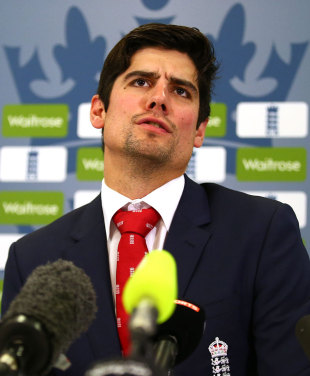
|
|||
|
Related Links
|
|||
On a cold, sunny February morning, Cook walked into a cramped hospitality box at Lord's and cheerfully apologised for disturbing journalists on what he imagined was a day off. He didn't look like a man relieved to have shed the burdens of office - not quite. Then again, he didn't look especially devastated either. But of one thing he was certain: after 59 Tests in charge, more than any England captain, his time was up.
The Cook years will go down as a period of stunning feats (two home Ashes wins, plus victories in India and South Africa) and navel-gazing misery (nine of his England-record 22 defeats came in two series, including an Ashes whitewash). In that respect, the team felt out of kilter with the captain: Cook was not naturally inclined to the end of any spectrum. Indeed, at the time of his resignation, he averaged fractionally more as captain (46.57) than he did in the ranks (46.36). He was reluctant to satisfy those in search of an easy headline, and stayed off Twitter, which was probably for the best, though some of the nastier stuff filtered through. During the winter in Asia, he displayed the sort of perspective that often suggests a captain has glimpsed life beyond coin tosses and bowling changes. Even his stubbornness had an endearingly human quality, though his delayed departure from the one-day job contributed to another World Cup fiasco, in 2015. Mainly, he emitted calm.
But he chose the right time to go. By his own admission, England's Test cricket had stagnated. This was partly a result of being lumbered with seven matches in less than nine weeks in Bangladesh and India, a touring schedule that must never be repeated. But the two meltdowns during his reign - Australia 2013-14 and India 2016-17 - reflected an abiding weakness. Lacking the tactical acumen to influence a game on its own, Cook was half the leader when he wasn't scoring runs. That his team lost only four of his 17 Test series in charge was testament to a very English grit: understated, occasionally self-conscious, always bloody-minded. It proved an exhausting combination.
Cook can now focus on the business of breaking more records with the bat, and offering advice from the slips to Joe Root. And he is well placed to suggest Root ignore the native pessimism about saddling the star batsman with the cares of captaincy. After all, Root's three main rivals among Test batting's twentysomething starlets have all flourished as leaders: when Cook stepped down, New Zealand's Kane Williamson had averaged 55 as captain (compared with 49 beforehand), Australia's Steve Smith 73 (compared with 51), and Kohli 63 (41). All three took over after fewer Tests than Root. If he's not ready now, he never will be.
Changing planes
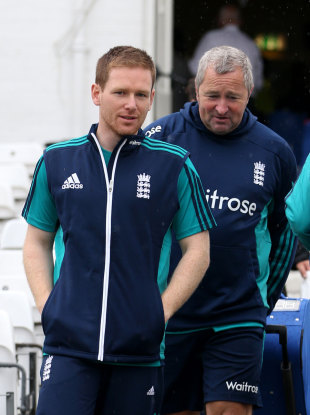
|
|||
Since England captains rarely learn on the job at county level any more, Root will have to absorb plenty, quickly - not least the quaint and enduring belief that he should operate on a higher moral plane than the rest of us. In September, the white-ball captain Eoin Morgan (along with Alex Hales) pulled out of the tour to Bangladesh because of security concerns. It was manna for the amateur psychologists. Some sympathised with the decision, while others regarded it as expediency disguised as principle: would Morgan and Hales, they wondered, have pulled out of a trip to India?
It's true that Morgan partly explained his nervousness by citing two explosions outside the Chinnaswamy Stadium in 2010, when he was in Bangalore's IPL squad, though he had returned to India in the meantime. But his point was that no team had toured Bangladesh since a terrorist attack in Dhaka on July 1. Despite the fact that the Foreign Office were offering similarly careful advice about Bangladesh and India, common sense told you one was riskier than the other. Any charge of hypocrisy had to look beyond the mandarins' caution.
In the event, the Bangladeshis put on a faultless security display, though that only strengthened the view of those who felt Morgan and Hales should have gone. And yet isn't the idea of safety deeply personal? Everyone has their own threshold; some may regard the assurances of security experts as too theoretical for comfort. Morgan said he couldn't be sure he would have been able to concentrate on the cricket, which ought to have silenced those who wondered about his commitment (and since when has not singing the national anthem been proof of anything?). Morgan's world-class hundred in Cuttack in January, in his second game back in charge, suggested his focus was better than ever. And England now knew that Jos Buttler could do the job too, having given a good account of himself in Bangladesh.
Morgan's next job is to translate England's white-ball potential into something tangible - and silver. As in Test cricket, they finished the year placed fifth in both the one-day and Twenty20 rankings, but those mid-table positions felt misleading rather than mediocre. Between the start of 2016 and the end of their 50-over runfest in India in January 2017, they had passed 300 ten times (more than any side in the world over the same period) and scored at 6.32 an over (no one else managed a run a ball). In April at Kolkata, they should have won the World Twenty20; in August at Trent Bridge, they made 444 for three against Pakistan, a 50-over world record; in January, they might have won a Twenty20 series in India if the umpiring had been more alert. They were rarely less than thrilling. This summer's Champions Trophy and the 2019 World Cup, both at home, will be ideal stages to remind critics that the English game is lucky to have Morgan.
With friends like that
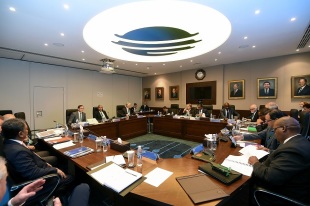
|
|||
In February in Dubai - four words that now loom annually over cricket - something remarkable happened: the world ganged up on India. At stake was the redistribution of ICC finances following the Big Three carve-up in early 2014, as craven an example of maladministration as cricket has seen. At the heart of the latest new world order was payback, quite literally.
Shashank Manohar, the ICC chairman and that rarest of beasts - an Indian administrator with a conscience - had promised to spread the funds more fairly, or less unfairly, which is the best cricket can generally hope for. Yet when the majority of Full Members came down in favour of a proposal to cut India's net share of the profits from the 2015-2023 broadcasting rights cycle from $450m to $260m, the BCCI's complaints would have rung a bell with anyone who recoiled at their heist three years earlier: India felt blindsided and bullied, and grumbled that two wrongs didn't make a right. It just wasn't… fair!
Not only did this suggest the Indians were finally ackowledging the iniquities of that heist, but it sounded suspiciously like the objection many had raised against the BCCI's behaviour under N. Srinivasan. During his reign, Indian officials would happily let it be known that they were simply doing to cricket what England and Australia had done for decades - treating it like a fiefdom. For many, the boardroom bargaining of February 2017 was a delightful irony.
Yet Schadenfreude isn't all it's cracked up to be. The provisional vote in Dubai took place at a time when the BCCI were struggling to rebuild after being hobbled by India's Supreme Court, and thus at their most vulnerable. Machiavelli would have approved of the ruthlessness, but it didn't say much for cricket's democratic processes. And among those happy to undo the bad work of 2014 were - you guessed it - England and Australia, the junior partners of Big Three Inc, who seemed determined to prove that opportunism takes many shapes and sizes.
If the proposals are officially approved later this year (though even an enfeebled BCCI can suck others into their orbit), then cricket could find itself on a new kind of terra infirma. The sport may be closer to financial equality than it was three years ago. But it will have got there using the same machinations that caused it such grief in the first place.
Contextual healing
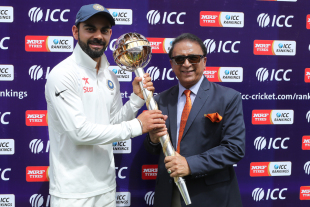
|
|||
India's hosting of 13 successive Tests between September 2016 and March 2017 was a kitchen-sink attempt to reintroduce the red ball to a nation that had fallen for the white (and, as luck would have it, a guarantee that India would go top of the rankings). Before last winter, their TV audiences for Test matches had halved since 2012, although the victory over England in Mumbai, where Kohli's 235 was more an apotheosis than an innings, was India's most-watched Test since the retirement of Sachin Tendulkar.
But the spike could not hide the trend: broadcasting rights for Tests around the world have plummeted in value. These days, the most lucrative games not involving Kohli take place in ICC global events and between Twenty20 franchises. Bilateral series struggling for TV money are beginning to feel like Warren Buffett's appraisal of the 2008 economic crash: you can't see who's swimming naked until the tide goes out. The Ashes are always well protected, though that is of little consolation to everyone else.
If the game really is serious about saving Test cricket - and too often Test cricket has had to take the administrators at their word - it must go further than skew the schedule. It must build a window in the international calendar for the IPL, the Big Bash and possibly one other domestic Twenty20 shindig. And - to beat an old drum - it must supplement the international game with the kind of context that makes those Twenty20 shindigs so easy to grasp for the casual sports fan, the key to cricket's survival in the years to come.
A proposal in February suggested a solution of sorts, a nine-team Test league spread over two years, culminating in a one-off final; three other sides - Zimbabwe plus, in all likelihood, Ireland and Afghanistan - would be assured of regular matches. It is a step in the right direction. But they need to go further.
Several months earlier, an eminently sensible proposal to split Test cricket into two divisions had met with predictable resistance. Objecting to a 12-team structure - seven in the first division, five in the second, with promotion, relegation, context, talking points, and a structure to grab that casual fan - Thilanga Sumathipala, president of Sri Lanka Cricket, complained: "We feel that, to make it a top seven, you are virtually relegating the bottom three [Full Members] to a different level." Surely not! Yet his objection, backed by India, won the day. And what emerged smacked of compromise: a nine-three split means the three are not so much a division as their own obscure genus.
By precluding, for the time being, the possibility of relegation, cricket has passed up the chance to borrow the seat-of-the-pants six-pointer from football, a refreshingly scrappy antidote to the glorious chase for the title. For a while now, the only headlines made by the rankings have revolved around who is top. This has provided some strong narratives, not least when Pakistan briefly became No. 1 in August, despite not having played a home Test for seven years. But a proper league structure needs every game to count. And nothing would focus the minds of complacent executives quite like the threat of relegation.
Perfect guests
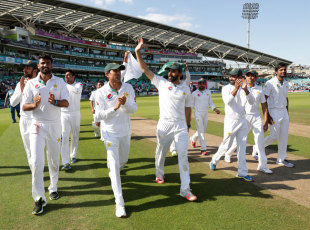
|
|||
Like the 2015 New Zealanders, the 2016 Pakistanis left England with everyone craving a decider; unlike them, Pakistan had arrived expecting headlines that went beyond the cricket. But, once Mohammad Amir had refused to overstep at Lord's, the cricket is precisely what made the headlines. This had plenty to do with the leadership of Misbah-ul-Haq, who showed it was possible to combine dignity and success. He also provided a poignant reminder of the human cost of Pakistan's exile, when - after his side's victory at The Oval - he quietly pointed out that he saw his sister and mother only once a year. And, flourishing as an international sportsman in his early forties, he gave hope to more of us than he probably realised.
Misbah was once mocked by sceptical fans for his "tuk tuk" approach, as another ball thudded off the face of a dead bat. But it was a simplification. Captaining Pakistan has always required skills more suited to defusing a brawl. To do so in the years since the 2009 terrorist attack in Lahore has also required a more nuanced ability - to persuade players they are doing something worthwhile. Pakistan's time as Test cricket's No. 1 side was fleeting, but it was a miracle they got there at all. And throughout, Misbah seemed to be enacting Hemingway's definition of courage as "grace under pressure".
A funny kind of home

|
|||
A visit to Mumbai provides confirmation that cricket is, more than it has ever been, an Indian sport. Its greatest metropolis has three Test grounds past and present within 20 minutes' walk, as well as countless future stars on the maidans and in the backstreets. Mumbai has cricket in every pore and artery. There are days when nothing else matters.
This makes what happened at the Wankhede Stadium during the Fourth Test against England all the sadder. While Indian cricket administrators were busy trying to save their careers during a stand-off with the Supreme Court, Indian cricket lovers suffered a string of indignities as they sought a pleasant time at the Test.
Queues outside the ground suggested little room for manoeuvre within, though the opposite was the case. If they hadn't lost the will to live by the time they reached the gates, Indian fans had to dump their rucksacks in an unguarded pile outside the stadium, while their English counterparts were allowed to take theirs in - because, according to one policeman, they couldn't be parted from their passports. One local was told that bottled water inside the ground was on sale to tourists only, an oversight that wasn't corrected until he took his grievance to Twitter. Many seats were soiled by bird poo, but then many seats were useless anyway, exposed to the sun until around 4pm, half an hour before the scheduled close; and, of course, bottles of sunscreen were also banned. Those seats that were shaded often sparked squabbles, regardless of who had booked what. The toilets were filthy. An Indian friend swore never to go again.
Yet Mumbai was hardly alone in turning what should have been a pleasure into an ordeal. The stadiums at Rajkot and Visakhapatnam, both making their Test debuts during the England series, are unhelpfully situated out of town; at Chennai, three vast stands stood empty because of an ongoing political dispute, which mocked the hordes of supporters stranded outside. Those who did gain entry should have been able to read all about it, except that staff were confiscating newspapers, without explanation.
Such is the lot of cricket lovers in India, who are fast becoming television's useful idiots - reassuring proof to those who invest in the game that it really is a sport for the masses.
Just when you thought you were safe…

|
|||
As if the Plague, the Great Chinese famine and the Holocaust had never happened, some wondered whether 2016 was the worst year in history. The climax of the County Championship clearly passed them by. In St John's Wood in late September, two of domestic cricket's most celebrated sides took the title to the wire. It needed a hat-trick from Toby Roland-Jones for Middlesex to pip Yorkshire - and Somerset, watching helplessly in the West Country. Even the tabloids took an interest.
But what Lord's giveth, it taketh away. Ten days after this good-news finale, it was announced that Durham - who had finished fourth - had been bailed out of financial strife by the ECB, but punished with relegation, a points deduction, and various other sanctions, not all suggesting even-handedness. Up in the North-East, they may have wondered whether the historians had a point. Expecting flak, the ECB depicted their ruling as the saviour of cricket in the region, and as a warning to others. Accusations flew back and forth on social media; simplified positions grew entrenched. The truth was somewhere in the middle: Durham had been reckless, the board draconian.
Yet serious questions demanded answers. When, for instance, had Durham's relegation been decided? A leak from a meeting suggested the board knew in May, though they deny this. But the possibility of relegation - and all involved must have known it was a possibility - was not conveyed to Durham's players. They deserved to know. In September, believing they were fighting for their first-division lives, Durham fielded fast bowler Mark Wood against Surrey; Wood aggravated an ankle injury, and was ruled out of England's winter tours, when his skiddy pace might have come in handy. Not only that, but other teams threw everything into avoiding a relegation which was 50% less likely than they realised. It would have been better to come clean about Durham's fate at the time. Instead, with games taking place which some officials appeared to know would be meaningless, the County Championship was brought into disrepute.
A few months after Durham's relegation, it emerged that their Academy had produced a higher percentage of first-team cricketers than any other. So the ECB must have squirmed when Hampshire, who would have been relegated in any normal year, bolstered their ranks at the start of 2017 with two South African Kolpaks, Rilee Rossouw and Kyle Abbott. Hampshire have not won the Championship since 1973; Durham, who didn't become a first-class county until 1992, have won three of the last nine.
Part of their problem since building an international venue - to satisfy the ECB's requirements for first-class status - was that they were always in the wrong place (in isolated Chester-le-Street, near a motorway junction, rather than in Newcastle or Durham itself), and usually at the wrong time (five of their six Tests were over by mid-June, before the arrival of the summer's sexier tourists). They have also lacked a powerful and reliable advocate. Other counties have had the help of rich personal backers (Graves and his family at Yorkshire, Rod Bransgrove at Hampshire), or generous county councils (Warwickshire), or even national assemblies (Glamorgan). Durham have had less luck. To punish them doubly, triply and more, felt like cricket's version of the postcode lottery. If they go straight back up in 2017 - and, despite a 48-point penalty, just you try stopping them - few promotions will have been cheered more loudly.
Free hit
Channel 5's bold decision to give Saturday-morning airtime to Australia's 2016-17 Big Bash League made some resounding points, none of them a pat on the back for the English game. They ensured the presence of live cricket on one of the UK's major free-to-air channels for the first time since the 2005 Ashes, when older readers may recall the sport felt like a national event. British fans who couldn't afford a satellite subscription thus had to rely on overseas matches for their fix. And, in the razzle-dazzle stakes, the Big Bash has left its English counterpart for dead. We knew this already, but live TV has a way of nailing the point.
While Colin Graves's eve-of-tournament description in May of the NatWest T20 Blast as "mediocre" had hints of Gerald Ratner and his crap jewellery, he was also on to something. Would an Australian broadcaster have done a Channel 5 in reverse and pay for the privilege of televising it? The answer is an unambiguous no.
An English city-based 20-over tournament will probably be with us in 2020, but it would have been sooner had the counties not argued over the details. It is a delay our game can barely afford, not least because part of the new competition's allure will be free-to-air coverage. Advocates of satellite paywalls insist the world has changed: youngsters, they say, barely watch television any more; the digital dissemination of cricket, they argue, is about creating noise in bitesized chunks on social media. Since recent research by the ECB suggested that more British children aged 7-15 recognised American wrestler John Cena than Alastair Cook, they could do with cranking up the volume.
There may be some truth in the advocates' argument. But it doesn't sit easily with Channel 5's claim that a total of 3.3 million viewers tuned into their six BBL shows. The debate over free-to-air cricket has disappeared so far up its own fundament that a basic truth has been lost: the sport needs viewers as much as it needs cash and coaches. Why else are the ECB pushing for terrestrial coverage in 2020? It's a nice idea. Here's hoping it's not too late.
Cricket's first lady
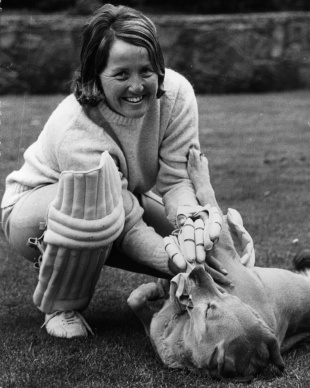
|
|||
The coincidence was strange. The day someone suggested MCC were thinking of making their Laws gender-inclusive - adding "or she" after every mention of "he" - news came through that Rachael Heyhoe Flint had died, at the age of 77. Death was the one thing she seemed incapable of; as Clare Connor explains later in these pages, she was a force of nature.
Heyhoe Flint would probably have chuckled at the extra pronoun, and no doubt regarded it as a sign of cricket's slow, awkward, but necessary embrace of the women's game. Truth be told, Wisden is not speaking from the moral high ground: she should have been a Cricketer of the Year - probably in 1974, the summer after she had beaten the men to it, and driven through the first women's World Cup.
That last sentence sums up part of the problem, for coverage of women's cricket has long fallen prey to unhelpful references to what the men have or haven't done. But, in the case of one of Heyhoe Flint's astute observations, we can probably make an exception. "Professional coaching," she reckoned, "is a man trying to get you to keep your legs together, when other men have spent a lifetime trying to get them apart." For her humour, as well as her revolutionary zeal, she will be missed.
Heavyweight champions
As Northamptonshire biffed their way to more Twenty20 success, it felt as if we finally had the answer to one of sport's oldest riddles: who ate all the pies? Wisden often looks for polite ways of describing the larger cricketer - portly, generously built, well upholstered. But Northamptonshire are used to the jibes, and didn't play as if they cared about euphemism. As much as anything, their two finals-day wins at Edgbaston against teams who clearly counted their calories were a reminder that, for all cricket's obsession with professionalism, there's still room for indulgence.
Leaders of the Weston world
Cricket was way ahead of the pollsters. As The Cricketer's February 2017 edition suggested, the result of last year's seismic election across the Atlantic was foretold by the scorecard of a humble county match at Weston-super-Mare, some three decades earlier. Surrey chose to bat against Somerset, quickly giving rise to the prophetic moment: Clinton c and b Trump 16. Never let anyone tell you sport and politics don't mix.

